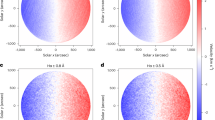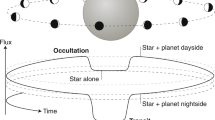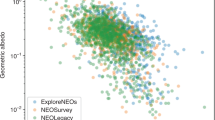Abstract
Sunspots are cool areas caused by strong surface magnetic fields that inhibit convection1,2. Moreover, strong magnetic fields can alter the average atmospheric structure3, degrading our ability to measure stellar masses and ages. Stars that are more active than the Sun have more and stronger dark spots than does the Sun, including on the rotational pole4. Doppler imaging, which has so far produced the most detailed images of surface structures on other stars, cannot always distinguish the hemisphere in which the starspots are located, especially in the equatorial region and if the data quality is not optimal5. This leads to problems in investigating the north–south distribution of starspot active latitudes (those latitudes with more starspot activity); this distribution is a crucial constraint of dynamo theory. Polar spots, whose existence is inferred from Doppler tomography, could plausibly be observational artefacts6. Here we report imaging of the old, magnetically active star ζ Andromedae using long-baseline infrared interferometry. In our data, a dark polar spot is seen in each of two observation epochs, whereas lower-latitude spot structures in both hemispheres do not persist between observations, revealing global starspot asymmetries. The north–south symmetry of active latitudes observed on the Sun7 is absent on ζ And, which hosts global spot patterns that cannot be produced by solar-type dynamos8.
This is a preview of subscription content, access via your institution
Access options
Subscribe to this journal
Receive 51 print issues and online access
$199.00 per year
only $3.90 per issue
Buy this article
- Purchase on SpringerLink
- Instant access to full article PDF
Prices may be subject to local taxes which are calculated during checkout


Similar content being viewed by others
References
Hale, G. E. On the probable existence of a magnetic field in sun-spots. Astrophys. J. 28, 315–343 (1908)
Biermann, L. Der gegenwärtige Stand der Theorie konvektiver Sonnenmodelle. Vierteljahresschrift Astron. Gesells. 76, 194–200 (1941)
Somers, G. & Pinnsoneault, M. H. Older and cooler: the impact of starspots on pre-main-sequence stellar evolution. Astrophys. J. 807, 174 (2015)
Strassmeier, K. G. Starspots. Astron. Astrophys. Rev. 17, 251–308 (2009)
Piskunov, N. E., Tuominen, I. & Vilhu, O. Surface imaging of late-type stars. Astron. Astrophys. 230, 363–370 (1990)
Bruls, J. H. M. J., Solanki, S. K. & Schuessler, M. Doppler imaging: the polar SPOT controversy. Astron. Astrophys. 336, 231–241 (1998)
Hathaway, D. F. The solar cycle. Liv. Rev. Sol. Phys. 12, 4 (2015)
Norton, A. A., Charbonneau, P. & Passos, D. Hemispheric coupling: comparing dynamo simulations and observations. Space Sci. Rev. 186, 251–283 (2014)
Kővári, Zs . et al. Doppler imaging of stellar surface structure. XXIII. The ellipsoidal K giant binary ζ Andromedae. Astron. Astrophys. 463, 1071–1080 (2007)
Berdyugina, S. Starspots: a key to the stellar dynamo. Liv. Rev. Sol. Phys. 2, 8 (2005)
Monnier, J. D., Berger, J.-P., Millan-Gabet, R. & ten Brummelaar, T. A. The Michigan Infrared Combiner (MIRC): IR imaging with the CHARA array. Proc. SPIE 5491, 1370–1378 (2004)
ten Brummelaar, T. A. et al. First results from the CHARA Array. II. A description of the instrument. Astrophys. J. 628, 453–465 (2005)
Korhonen, H. et al. Ellipsoidal primary of the RS CVn binary ζ Andromedae. Investigation using high-resolution spectroscopy and optical interferometry. Astron. Astrophys. 515, A14 (2010)
Kővári, Zs . et al. Measuring differential rotation of the K-giant ζ Andromedae. Astron. Astrophys. 539, A50 (2012)
Reiners, A., Basri, G. & Browning, M. Evidence for magnetic flux saturation in rapidly rotating M stars. Astrophys. J. 692, 538–545 (2009)
Spruit, H. C. Effect of spots on a star’s radius and luminosity. Astron. Astrophys. 108, 348–355 (1982)
López-Morales, M. On the correlation between the magnetic activity levels, metallicities, and radii of low-mass stars. Astrophys. J. 660, 732–739 (2007)
Unruh, Y. C. & Collier Cameron, A. Does chromospheric emission mimic polar starspots in Doppler images? Mon. Not. R. Astron. Soc. 290, L37–L42 (1997)
Bruls, J. H. M. J., Solanki, S. K. & Schuessler, M. Doppler imaging: the polar SPOT controversy. Astron. Astrophys. 336, 231–241 (1998)
Strassmeier, K. G. et al. Doppler imaging of high-latititude SPOT activity on HD 26337. Astron. Astrophys. 247, 130–147 (1991)
Piskunov, N. & Wehlau, W. H. The detectability of cool polar caps on late type stars. Astron. Astrophys. 289, 868–870 (1994)
Bushby, P. J. Strong asymmetry in stellar dynamos. Mon. Not. R. Astron. Soc. 338, 655–664 (2003)
Bouvier, J. & Bertout, C. Spots on T Tauri stars. Astron. Astrophys. 211, 99–114 (1989)
Parks, J. R. et al. First images of cool starspots on a star other than the Sun: interferometric imaging of λ Andromedae. Astrophys. J. (submitted); preprint at http://arxiv.org/abs/1508.04755 (2016)
Oláh, K. et al. Magnitude-range brightness variations of overactive K giants. Astron. Astrophys. 572, A94 (2014)
Stassun, K. G., Kratter, K. M., Scholz, A. & Dupuy, T. J. An empirical correction for activity effects on the temperatures, radii, and estimated masses of low-mass stars and brown dwarfs. Astrophys. J. 756, 47 (2012)
MacDonald, J. & Mullan, D. J. Structural effects of magnetic fields in brown dwarfs. Astrophys. J. 700, 387–394 (2009)
Chabrier, G., Gallardo, J. & Baraffe, I. Evolution of low-mass star and brown dwarf eclipsing binaries. Astron. Astrophys. 472, L17–L20 (2007)
ESA The Hipparcos and Tycho Catalogues. ESA SP-1200, http://www.cosmos.esa.int/web/hipparcos/catalogues (ESA, 1997)
Fekel, F. C., Strassmeier, K. G., Weber, M. & Washuettl, A. Orbital elements and physical parameters of ten chromospherically active binary stars. Astron. Astrophys. Suppl. Ser. 137, 369–383 (1999)
Kjurkchieva, D. P. New analysis of II Peg 1977 light curve. Astrophys. Space Sci. 155, 125–129 (1989)
Vogt, S. S. & Penrod, G. D. Doppler imaging of spotted stars—application to the RS Canum Venaticorum star HR 1099. Publ. Astron. Soc. Pacif. 95, 565–576 (1983)
Harmon, R. O. & Crews, L. J. Imaging stellar surfaces via matrix light-curve inversion. Astron. J. 120, 3274–3294 (2000)
Monnier, J. D. et al. Imaging the surface of Altair. Science 317, 342–345 (2007)
Monnier, J. D. et al. Resolving Vega and the inclination controversy with CHARA/MIRC. Astrophys. J. 761, L3 (2012)
Roettenbacher, R. M. et al. Detecting the companions and ellipsoidal variations of RS CVn primaries. I. σ Geminorum. Astrophys. J. 807, 23 (2015)
Pauls, T. A., Young, J. S., Cotton, W. D. & Monnier, J. D. A data exchange standard for optical (visible/IR) interferometry. Publ. Astron. Soc. Pacif. 117, 1255–1262 (2005)
Bonneau, D. et al. SearchCal: a virtual observatory tool for searching calibrators in optical long baseline interferometry. I. The bright object case. Astron. Astrophys. 456, 789 (2006)
Baron, F. et al. CHARA/MIRC observations of two M supergiants in Perseus OB1: temperature, Bayesian modeling, and compressed sensing imaging. Astrophys. J. 785, 46 (2014)
Moultaka, J., Ilovaisky, S. A., Prugniel, P. & Soubiran, C. The ELODIE archive. Publ. Astron. Soc. Pacif. 116, 693–698 (2004)
Górski, K. M., Hivon, E., Banday, A. J., Wandelt, B. D., Hansen, F. K., Reinecke, M. & Bartelmann, M. HEALPix: A framework for high-resolution discretization and fast analysis of data distributed on the sphere. Astrophys. J. 622, 759–771 (2005)
Foreman-Mackey, D., Hogg, D. W., Lang, D. & Goodman, J. emcee: the MCMC hammer. Pub. Astron. Sci. Pacif. 125, 306–312 (2013)
Kurucz, R. L. Model atmospheres for G, F, A, B, and O stars. Astrophys. J. Suppl. Ser. 40, 1–340 (1979)
Acknowledgements
We thank E. Pedretti for his early efforts in imaging ζ And. This work is based upon observations obtained with the Georgia State University Center for the High Angular Resolution Astronomy Array at Mount Wilson Observatory. The CHARA Array is supported by the National Science Foundation under grant numbers AST-1211929 and AST-1411654. Institutional support has been provided from the GSU College of Arts and Sciences and the GSU Office of the Vice President for Research and Economic Development. The MIRC instrument at the CHARA Array was funded by the University of Michigan. The 2013 CHARA/MIRC observations were supported by a Rackham Graduate Student Research Grant from the University of Michigan. This imaging work was supported by the National Science Foundation (NSF) grant AST-1108963. The SURFING software was developed in part with funding from the Observatoire de Paris, Meudon. This research made use of the SIMBAD database, operated at CDS, Strasbourg, France and the Jean-Marie Mariotti Center SearchCal and Aspro2 services co-developed by FIZEAU and LAOG/IPAG. This work was supported by the Hungarian Scientific Research Fund (OTKA K-109276), the ‘Lendület-2009’ Young Researchers’ programme of the Hungarian Academy of Sciences, an STFC Rutherford Fellowship and Grant (ST/J004030/1, ST/K003445/1), and an ERC Starting Grant (grant agreement number 639889).
Author information
Authors and Affiliations
Contributions
R.M.R., J.D.M., F.B., X.C., S.K. and M.Z. obtained the observations of ζ And. R.M.R., J.D.M., F.B., X.C., S.K., G.H.S. and M.Z. obtained the observations of 37 And. R.M.R. performed the data reduction and calibration. R.M.R. and G.T. determined the orbital parameters of 37 And. J.D.M. and R.M.R. created the images of ζ And, which were interpreted by R.M.R., J.D.M., H.K., Zs.K., R.O.H. and A.N.A. T.A.t.B., G.H.S., J.S. and L.S. provided observational setup and technical support.
Corresponding author
Ethics declarations
Competing interests
The authors declare no competing financial interests.
Extended data figures and tables
Extended Data Figure 1 Visibility curve of UT 15 September 2013 observations of ζ And with CHARA/MIRC.
The observed visibilities (unitless) are plotted in black with 1σ error bars and the SURFING model visibilities are overlaid in red.
Extended Data Figure 2 Closure phases of UT 15 September 2013 observations of ζ And with CHARA/MIRC.
Each block represents a temporal block of closure phase (CP) observations with data plotted in black (with 1σ errors) and SURFING model in red. Each row represents the CP from a unique set of three telescopes, labelled in the standard CHARA format.
Extended Data Figure 3 Orbit of 37 And.
The grey plus signs represent measurements of the companion (1σ errors on detections are smaller than the symbols). The observed resolved disk of 37 And is plotted as the black dot at the origin. The thin solid black line is the best-fit orbit from combining the interferometric detections and the ELODIE radial velocities. Note that the axis units are milliarcseconds (mas) with north up and east to the left.
Extended Data Figure 4 Radial velocity curve of the primary star of 37 And.
The data points are based upon archival ELODIE spectra (with 1σ error bars). The orbital solution used the velocity measurements and the interferometric measurements simultaneously. The solid line is the best-fit orbit and the grey lines are fifty Monte Carlo realizations of the orbit.
Extended Data Figure 5 Reduced, normalized χ2 surface plot of the SURFING model fitted for position angle and inclination of ζ And.
The peak is found at PA = 126.0° ± 1.9 and i = 70.0° ± 2.8. The epoch of each data set is located in the upper left of each panel. The different colours represent varying normalized χ2 values with the black contours labelled with specific values.
Extended Data Figure 6 Comparison of the 2013 CHARA/MIRC data set divided into two sets of seven nights of data.
These projections are plotted in the same way as the Aitoff projection in Fig. 2.
PowerPoint slides
Rights and permissions
About this article
Cite this article
Roettenbacher, R., Monnier, J., Korhonen, H. et al. No Sun-like dynamo on the active star ζ Andromedae from starspot asymmetry. Nature 533, 217–220 (2016). https://doi.org/10.1038/nature17444
Received:
Accepted:
Published:
Issue Date:
DOI: https://doi.org/10.1038/nature17444
This article is cited by
-
Astrophotonics: astronomy and modern optics
The Astronomy and Astrophysics Review (2021)
-
A recent history of science cases for optical interferometry
Experimental Astronomy (2018)
-
Interferometry in the era of time-domain astronomy
Experimental Astronomy (2018)
-
Magnetism, dynamo action and the solar-stellar connection
Living Reviews in Solar Physics (2017)




